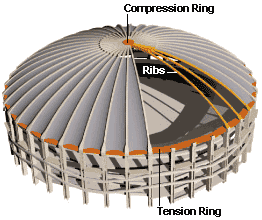 |

|

|
Sunday, March 19, 2000
Defying gravity
The roof of the Kingdome is the largest concrete dome in the world, spanning
660 feet. It is held up by a balance of pressure between its inner and outer
rings the compression ring in the middle anchors the tops of the ribs,
while the encircling tension ring keeps the ribs' bases in place.
The key to the implosion is to release this pressure by breaking the ribs in
the middle. When this happens, most of the structure should collapse
inward.
Compression ring
Anchors ribs in the center of the roof. It pushes down on the ends of the
ribs, which in conjunction with the inward pressure exerted by the tension
ring creates the arch in the ribs that supports the weight of the roof.
The 28.8-foot wide, 7.5-foot thick plug will be broken up in the second
phase of the implosion and will fall on a 25-foot cushion of crushed
concrete below.

Tension ring
Keeps ribs from sliding outward. The 25-foot wide, 2-foot thick ring is
composed of multiple lengths of steel cable encased in concrete. Since the
cables won't break during the implosion, they will help keep debris within
the footprint of the Kingdome.
 |
|
Dome statistics
|
 |
|
Building area: |
9.34 acres |
 |
|
Roof area: |
7.85 acres |
 |
|
Height: |
250 feet |
 |
|
Diameter: |
660 feet (inside wall) |
|
|
720 feet (exterior walls) |
 |
|
Volume: |
67 million cubic feet |
 |
| Exhibit space: |
190,400 square feet |
 |
| Weight: |
130,000 tons |
 |
|
Structural steel: |
443 tons |
 |
|
Concrete: |
52,800 cubic yards |
 |
Graphics and text: Phil Loubere; Reporting and text: Whitney Stensrud; Reporting: Jeff Hodson / © 2000 The Seattle Times

|

